
Maintenance
Proper maintenance of the roadway and its traffic control devices can forestall or ameliorate some of the problems identified in this Guide. Agencies should have a scheduled maintenance program that includes the activities noted below, as a minimum.
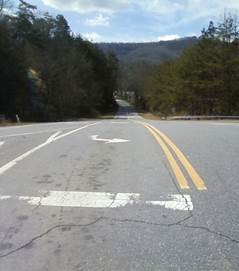
Worn stop line should be restriped. Source: VHB.
Restripe deteriorated pavement markings
Pavement markings using paint-based materials have a relatively short service life—one to two years depending upon the material type, climate, and traffic volume. Those using other materials (e.g., thermoplastic, epoxy, preformed plastic markings) have a substantially longer service life. To maintain their effectiveness, pavement markings need to be discernible, especially during nighttime and limited-visibility conditions. Agencies should have an inspection and restriping program to ensure that pavement markings provide the visibility that is needed by motorists. Further information on pavement marking visibility can be found on the FHWA Office of Safety Website.
Replace faded, damaged, or missing signs
The various standard signs discussed in the Unsignalized Intersection Improvement Guide (UIIG) are visible at night because they are made with retroreflective sheeting material; few, if any, are illuminated by external lighting. The composition of the sheeting material has changed over the years to provide brighter and longer-lasting signs. However, all signs will deteriorate over time, eventually losing their color and retroreflectivity such that they no longer provide adequate recognition or visibility distance for the motorist. MUTCD Section 2A.08 (Maintaining Minimum Retroreflectivity) requires that “public agencies or officials having jurisdiction shall use an assessment or management method that is designed to maintain sign retroreflectivity at or above the minimum levels in Table 2A-3” and identifies the following five methods for managing sign retroreflectivity:
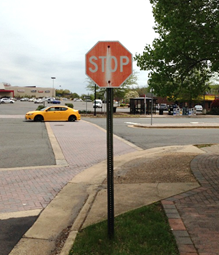
A STOP sign in need of replacement. Source: VHB.
- Visual nighttime inspection.
- Measured sign retroreflectivity using a retroreflectometer.
- Expected sign life.
- Performance of control group of signs.
- Blanket replacement.
Detailed information about sign retroreflectivity requirements and the methods listed above can be found at the FHWA Office of Safety website.
It is worth noting that—in addition to the inevitable degradation due to their exposure to the natural elements—signs are also susceptible to vandalism (e.g., paint, stickers, bullets, etc.) and damage from errant vehicles. Regardless of the root cause, any sign that is faded, defaced, damaged, leaning, or missing should be evaluated for prompt replacement. Critical regulatory signs such as STOP or YIELD signs and important warning signs should have a higher level of monitoring and a more timely maintenance response.
Trim or remove foliage
Maintaining adequate sight distance to an intersection is critical to its safety. During the growing season, grass, crops, weeds, brush, and tree limbs can limit a driver’s view of the road, traffic signs, and other road users. Periodic inspections of the roadway should be made to detect and correct these conditions. Practical tips for controlling vegetation overgrowth can be found in FHWA’s Vegetation Control for Safety: A Guide for Local Highway and Street Maintenance Personnel. Furthermore, trees or plants should not be located where maintenance is not available to control future growth and prevent occlusion of traffic signs and/or intersection sight distance.

Motorists’ view of the STOP sign is blocked by foliage until they reach the stop line. Source: VHB.
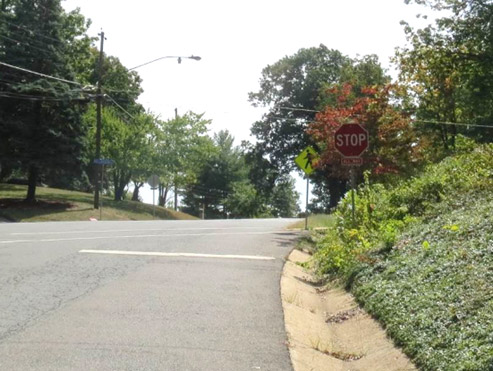
Removing the foliage drastically improved visibility of the STOP sign. Source: VHB.
Maintain barriers and devices targeting roadside safety
Run-off-road crashes can occur within or along the approach to an intersection where fixed objects or non-traversable slopes may be present. When such roadside hazards cannot be eliminated, their presence may be mitigated through the installation of traffic control devices (e.g., object markers) or a barrier system. It is imperative that any installed measure be properly maintained in the event it is damaged or degraded to ensure it performs in its intended manner. Examples of related maintenance practices include replacing damaged object markers, repairing damaged guardrail sections or end treatments, and replacing damaged or missing reflectors on barrier or other roadside objects. Further information on the treatment of roadside hazards can be found in Chapter 5 of the FHWA publication Road Safety Fundamentals, as well as in the AASHTO Roadside Design Guide.
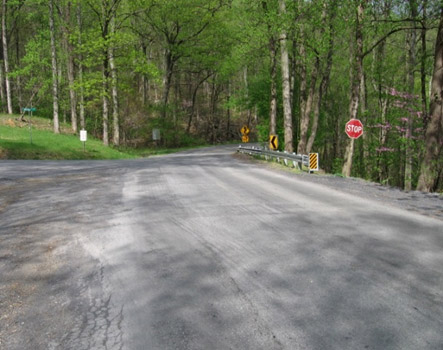
Barrier may be warranted at intersections to shield users from roadside hazards. Source: VHB.
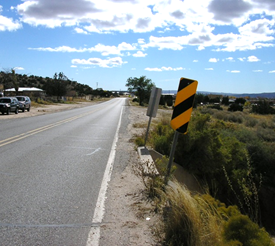
Object markers may be used to mark obstructions or conditions adjacent to an intersection or intersection approach.
Source: VHB.
Improve the drainage within and near the intersection
Improper and inadequate roadway drainage can cause water to pond on the travel lanes and shoulder areas. This can be particularly troublesome within or on the approach to an intersection. If water is not drained properly, then more rapid pavement and shoulder deterioration may occur, resulting in potholes, pavement drop-offs, and reduction in the useable shoulder. Sometimes water ponding can be caused by settlement of the roadway and require reconstruction, but, in most cases, less obtrusive maintenance can resolve the drainage and ponding issues. Ditches or inlets may need to be cleared of debris, or curbing and improved drains may need to be installed and subsequently maintained (see photos below). Tips on road drainage features that are important to safety can be found in the FHWA publication Maintenance of Drainage Features for Safety.
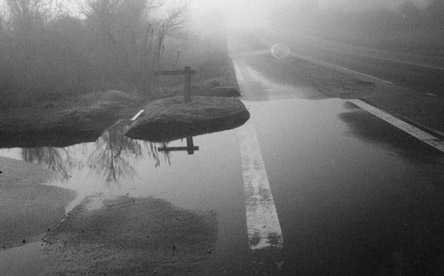
In this photo, water is ponding because the outflow ditch has silted up. Ponded water can cause drivers to leave their lane, reduce braking ability, or contribute to pavement deterioration. Source: FHWA.
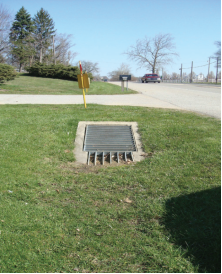
This grated inlet can be used to prevent water ponding at access points. Source: FHWA.

